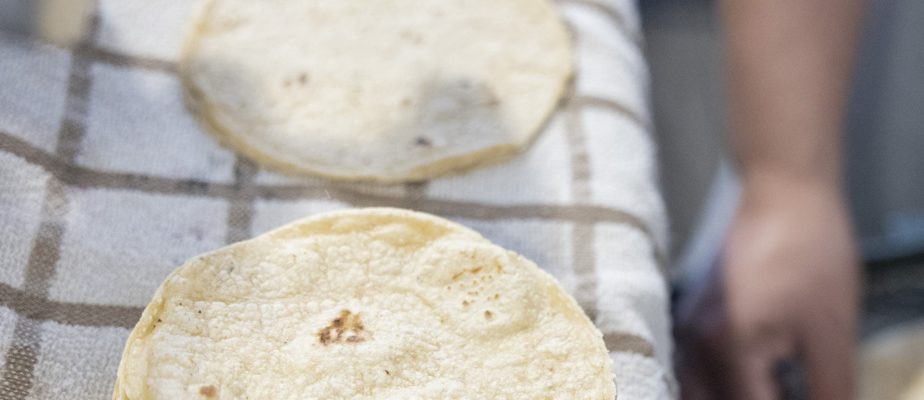Good things come to those who wait for. This is what I tell myself, sitting at Alma, while I taste the exquisite “carte blanche” menu of chef Juan Lopez Luna. Montreal finally has its “modern Mexican cuisine” restaurant. It took a whole combination of circumstances to make this experience possible. The central element: the masa.
Let’s go back to the very beginning of this happy epic. After reading the file “In search of the perfect tortilla”, published in The Press in January 20191Roberto Flores Lozano understood that the good pancake of his childhood still did not have its equivalent in his adopted province.

PHOTO MARCO CAMPANOZZI, THE PRESS
It was after reading an article in The Press that Roberto Flores Lozano decided to start his project.
In November 2020, in the middle of a pandemic, the Sherbrooke resident from Poncitlan, a small municipality not far from Guadalajara, decided to remedy the situation by launching La Quebequita. The tiny tortilleria produces its masa according to the rules of the art.
Masa, a corn dough, is the cornerstone of Mexican cuisine. We make tortillas, of course, but also tetelas, memelas, tamales, gorditas, sopes, tlayudas, Oaxacan empanadas, atole (a hot drink), etc.
It may seem simple, but it is far from it. To obtain a truly good traditional masa, you must first find the appropriate and ideally ancestral variety of corn (we say criollo in Spanish). It is a grain corn, therefore a cereal, and not a vegetable corn like the one we eat in the summer on the cob.
La Quebequita
-

PHOTO MARCO CAMPANOZZI, THE PRESS
Nixtamalized corn being ground to form masa
-

PHOTO MARCO CAMPANOZZI, THE PRESS
Fresh masa
-

PHOTO MARCO CAMPANOZZI, THE PRESS
It is in this squeaky machine that the masa becomes a tortilla!
-

PHOTO MARCO CAMPANOZZI, THE PRESS
The small workshop in Sherbrooke produces around 5,500 tortillas per week, on Fridays and Saturdays only.
-

PHOTO MARCO CAMPANOZZI, THE PRESS
Friday tortillas!
-

PHOTO MARCO CAMPANOZZI, THE PRESS
Roberto Flores Lozano weighs a kilo of tortillas.
-

PHOTO MARCO CAMPANOZZI, THE PRESS
This volcanic stone is the secret to a perfect grind.
1/7
The grain is “nixtamalized,” that is, cooked in water to which an alkaline ingredient, such as edible lime, has been added. First of all, these are two ingredients that are not easily found here.
By 2019, my quest for the perfect tortilla had ended up in Toronto, because, according to my extensive digging, no one was producing masa from the grain in Quebec. Since then, La Capital Tacos sometimes makes batches of fresh masa, but it’s very occasional.
The tortillas that we can buy in Quebec are made from masa flour (masa harina in Spanish) industrial, by the omnipresent company Maseca, which can even be purchased in supermarkets in Quebec. In truth, for years a large part of tortillas in Mexico have also been produced with this flour.
A question of taste… but that’s not all

PHOTO MARCO CAMPANOZZI, THE PRESS
Tortillas from the Sherbrooke tortilleria La Quebequita
Why make the distinction? Let’s talk about taste first. Maseca being a multinational with more than 75 factories, it uses very large crop corn, with very high yield rather than very high taste quality.
Then there is the social and political aspect. In his book masaJorge Gaviria explains how, upon the ratification of the North American Free Trade Agreement (NAFTA), cheap American corn invaded Mexico, allowing Maseca to produce at low cost, while killing many small farms who cultivated according to the pre-Columbian milpa system (the “three sisters” that the First Nations here also use or used).
Thirty years later, Mexican farmers are reaffirming the importance of this biodiverse agricultural method. Jorge Gaviria has a great company that produces masa harina quality, Masienda, but it does not deliver to Canada.

PHOTO MARCO CAMPANOZZI, THE PRESS
In the brown bags, Roberto’s corn. In the plastic bins, blue corn from chef Juan Lopez Luna.
The large pockets of white corn that adorn an entire wall of the tiny place with red doors in La Quebequita demonstrate that we can do things differently. Roberto imports his grain from the United States. He doesn’t know the exact origin, but it’s a start.
He purchased the equipment necessary to make approximately 100 kilos of tortillas per week (5,500 tortillas), i.e. a fairly small mill and another larger machine, which presses and cooks the tortillas.

PHOTO MARCO CAMPANOZZI, THE PRESS
La Quebequita is located on Wellington South Street, in Sherbrooke.
Uprooted Mexicans and other Latin Americans who grew up with masa enter the Wellington Street tortilleria and exclaim: “It smells like my childhood!” » Some also find that it “sounds” like they did in their childhood. The squeaks of the equipment remind them of the almost daily visits to the village or town counter.
You can come and buy your fresh tortillas on site on Fridays and Saturdays. Several families leave with their kilo, which lasts all week. You can even buy the masa frozen and make your own tortillas and other recipes at home.
The Gato restaurant, in Sutton, serves its tacos, enchiladas and other quesadillas in La Quebequita tortillas. In summer, Sherbrooke pancakes are also on the menu at the Robin natural beer canteen, in Waterloo, among others. And finally, in Montreal, it is at Alma and nowhere else that you can taste La Quebequita’s nixtamalized corn paste.
